Korean beef radish soup is a simple yet hearty and flavorful soup. It’s made with thinly sliced beef, Korean radish, and aromatics served in a delicious and comforting soup. It’s exactly what you need on a chilly day or when you need a pick-me-up.
Hot and refreshing is how I like to describe this Korean beef radish soup. It’s not something that I’d ever thought would make sense together but it just does! Each sip of this flavorful broth warms my soul and brings comfort. It’s beefy, umami, hearty, and filling. The radish also adds a subtle sweetness and body to the soup. This soup is great on its own but is usually served with rice and ‘banchan’ or side dishes such as:
- Geotjeori Kimchi
- Korean Cucumber Kimchi
- Vegetable Pancakes
- Korean Radish Salad
- Spicy Asian Cucumber Salad
- Korean Silken Tofu
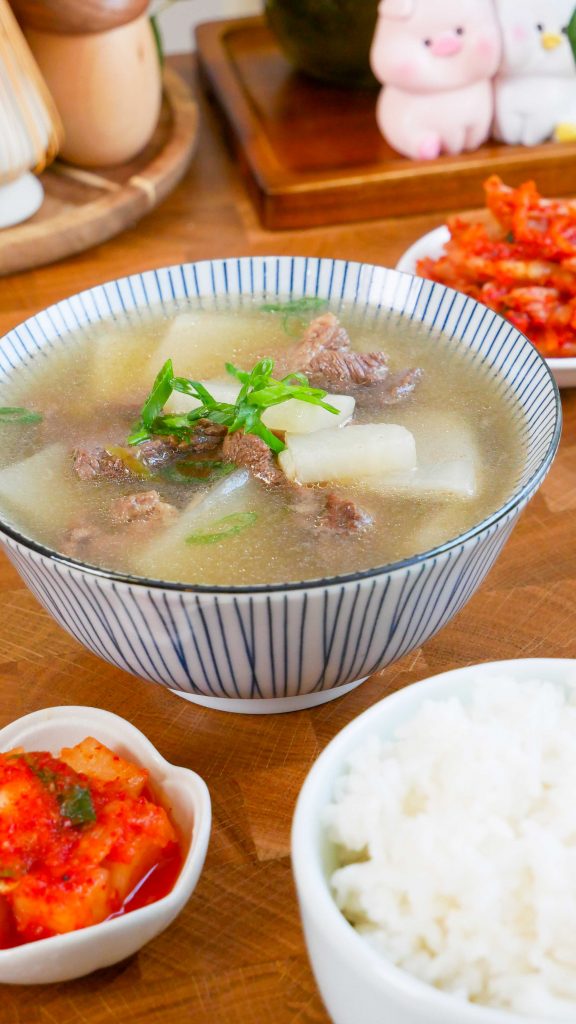
Why you’ll love this recipe
Apart from being absolutely delicious, this beef radish soup is one of the easier Korean soups to prepare. As the recipe name suggests, it’s made up of two major components – beef and radish!
The beef is thinly sliced and then marinated in a quick and delicious sauce made of soy sauce, garlic, and sesame oil. To maximize flavor, the marinated beef is sauteed until brown, which deepens the flavor of the beef.
Korean radish, the co-star of this soup, makes the broth incredibly delicious and comforting. When cooked, radish is mild in flavor with a subtle hint of sweetness, which deliciously complements the beef. Each bite of the radish is soft, tender, and juicy!
Aside from the beef and Korean radish, you’ll only need a handful of ingredients! Best of all, everything comes together in just 45 minutes. Once the ingredients are added to the pot, you just need to let it simmer away so it requires minimal attention.
Since this soup is not spicy, it’s great for kids. But if you want to make it spicy, you can add a dash of gochugaru or Korean red chili flakes.
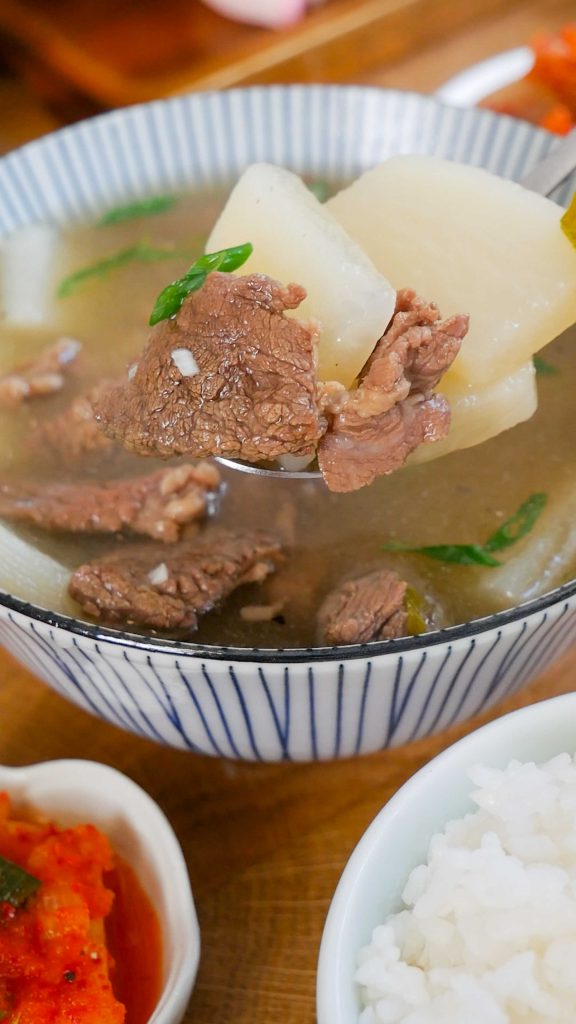
Korean Beef Radish Soup Ingredients and Substitutions
Beef brisket or chuck: I like to use either beef brisket or beef chuck because they are affordable and on the leaner side. Marinating and searing them even enhances their savory flavor. Short ribs are also a good alternative but they are pricey!
Soy sauce: Helps tenderize and season the beef. I like using the Sempio brand.
Sesame oil: Adds a nutty taste and also helps in searing the beef. My go-to sesame oil brand is Kadoya.
Garlic cloves: Deepens the flavor of the soup and also adds a delicious garlicky aroma. Feel free to add more but not less! The beef marinade can be substituted with garlic powder you need to use fresh garlic for the soup.
Korean radish: Korean radish is rounded with a greenish-white skin, compared with daikon radish which is elongated and purely white. Korean radish is crisp when raw, but turns soft, sweet, and juicy when cooked. It has a mild flavor that compliments the beef and contributes to the overall flavor of this soup. Can be substituted with daikon radish.
Dried kelp: Adds umami and deepens the flavor of the soup. This can be substituted with 1 tsp dashi powder. If using dashi powder, adjust the seasoning (fish sauce, salt, or dashida).
Scallions: Adds freshness and a subtle oniony flavor. This can be substituted with chives
Fish sauce: Seasons the soup and also adds another layer of umami. This can be substituted with soup soy sauce or salt.
Salt: Used for seasoning
Dashida: This is Korean beef bouillon powder that adds umami and flavor to the soup. This is optional but highly recommended. It can be substituted with beef bouillon cubes.
Water: For soup base
Neutral oil: Used for searing the marinated beef. Any neutral-tasting oil would work including corn, canola, vegetable, avocado, grapeseed, and sunflower seed oil. I usually use avocado oil.
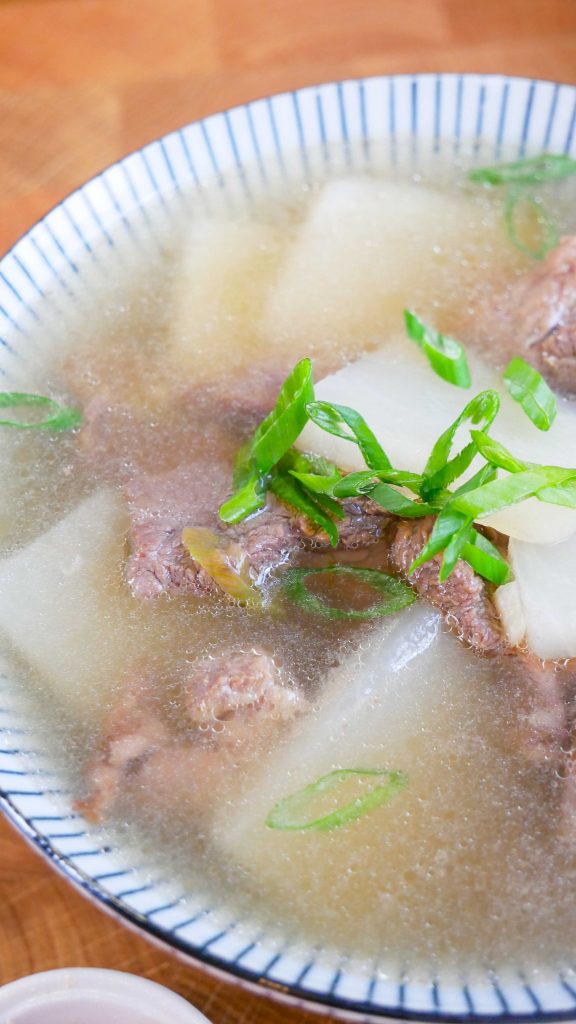
How to prepare Korean Beef Radish Soup
Step 1: Slice the beef
Start by slicing the beef thinly, about 1/4 inch pieces.
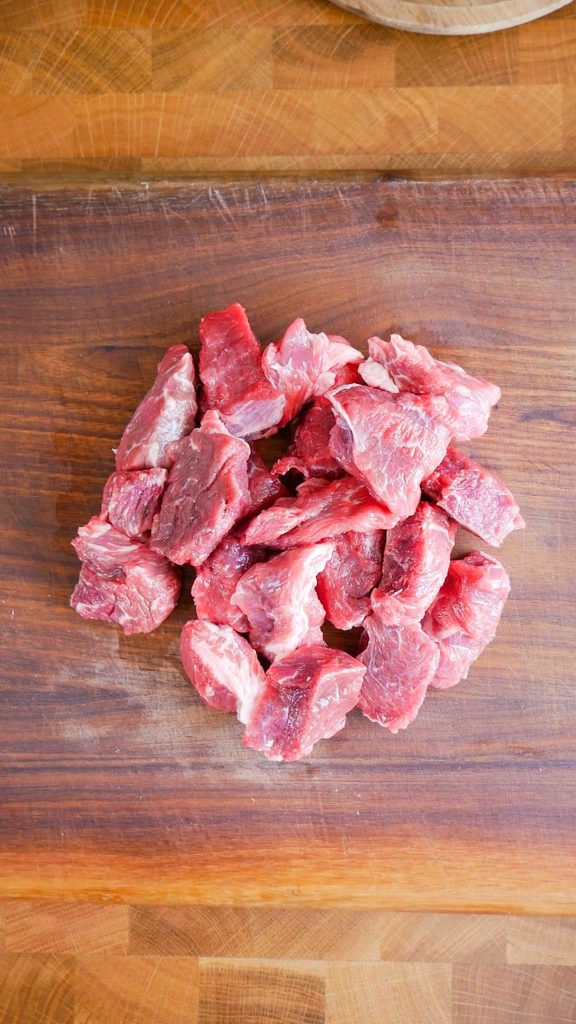
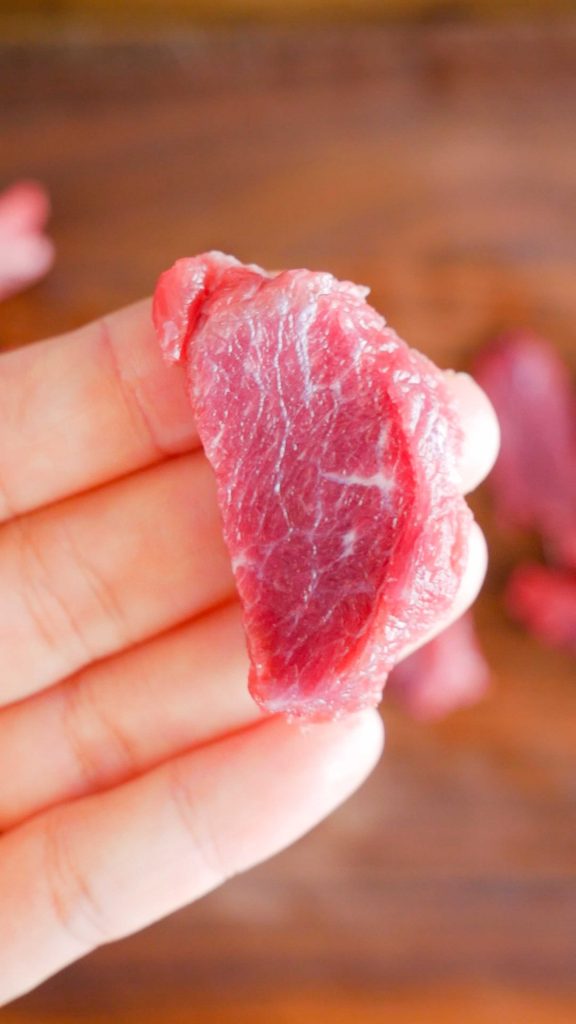
Step 2: Marinate the beef
Transfer the sliced beef into a small mixing bowl. Add soy sauce, sesame oil, and 2 minced garlic cloves. Mix well then set aside to marinate at room temperature for 15 minutes.
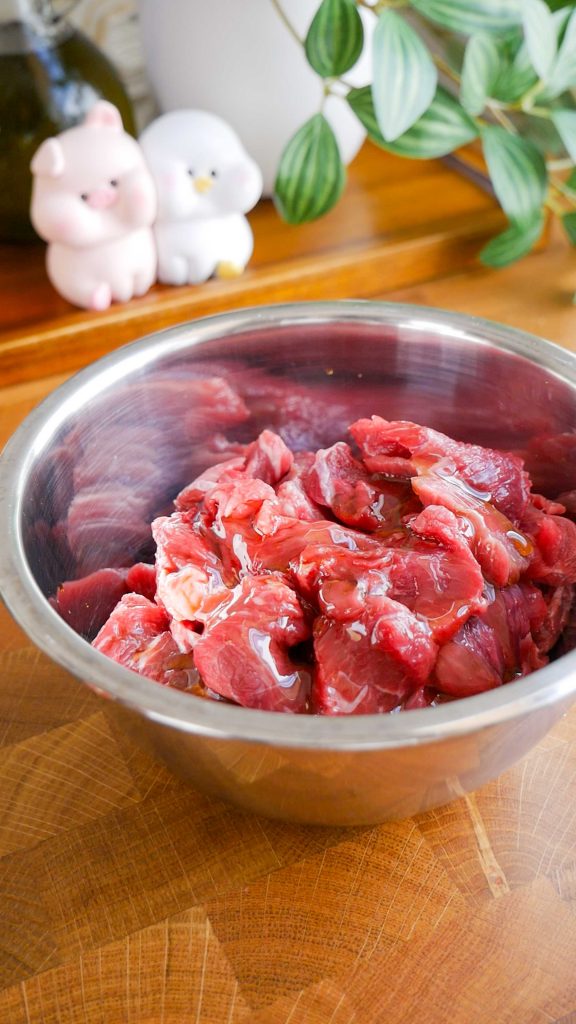
Step 3: Slice the radish
While the beef is marinating, slice the radish 1/4 inch thick slices.
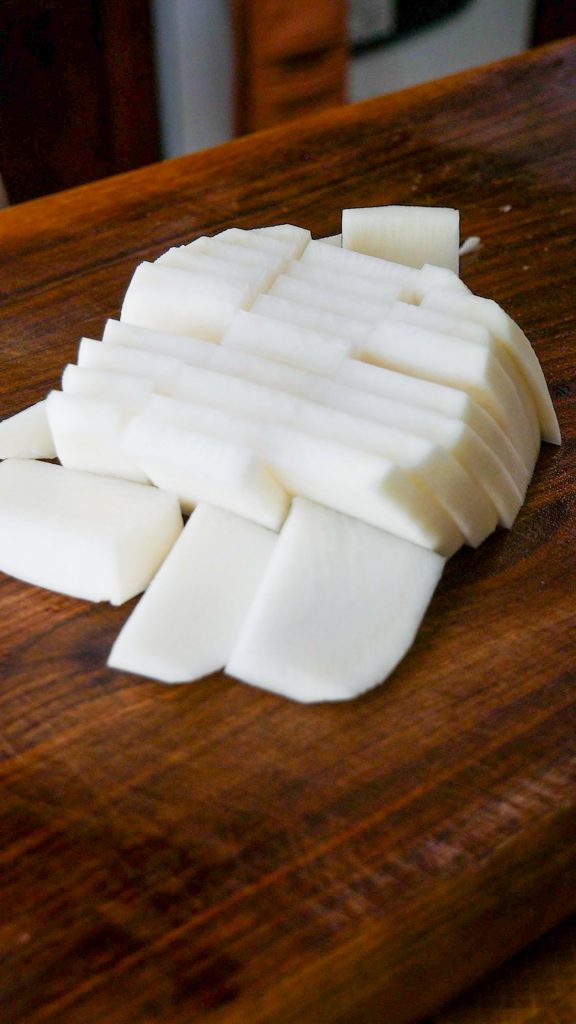
Step 4: Saute the beef
Heat a pot over medium heat, then add neutral oil. Once the oil is hot, add the marinated beef and saute for 1 to 2 minutes until no longer pink.

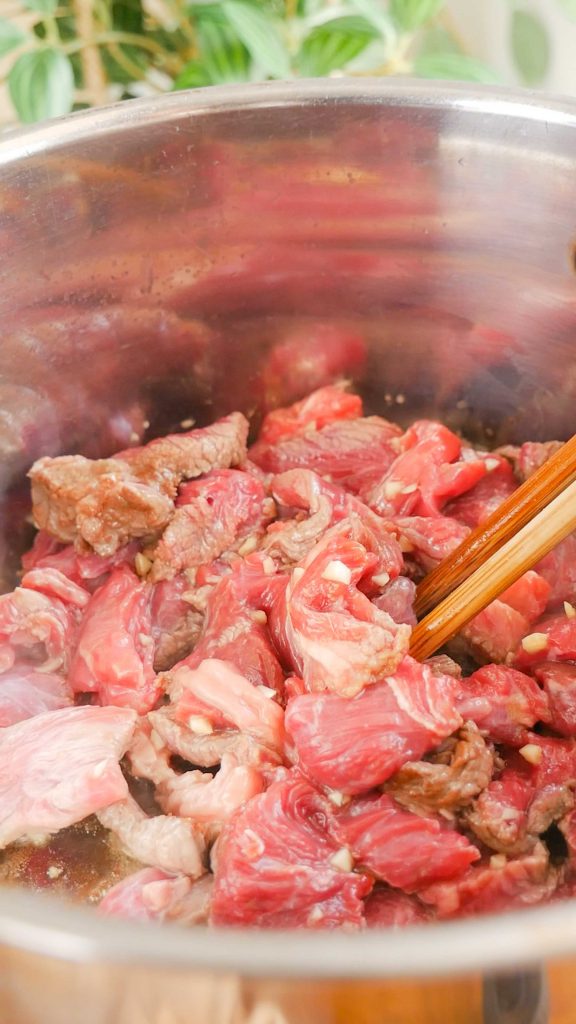
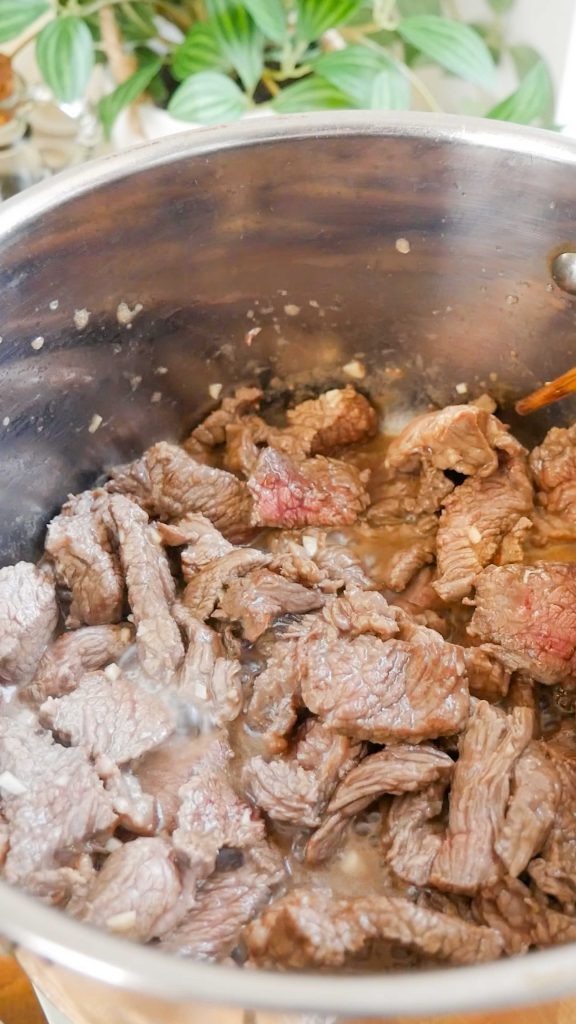
Step 5: Cook the radish
Add the radish to the pot then cook for 1 to 2 minutes.
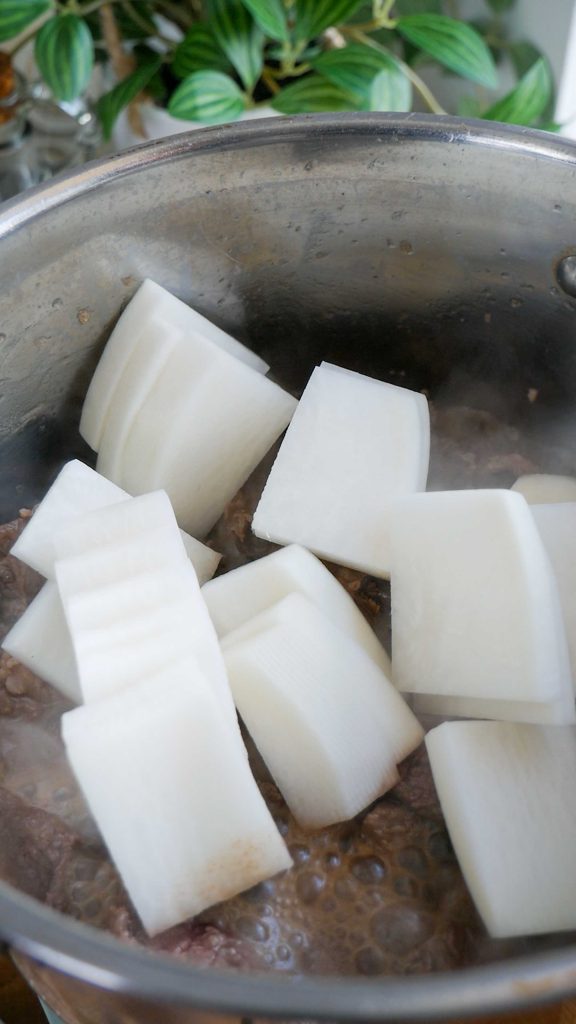
Step 6: Make the stock and simmer
Pour in the water, then add the dried kelp. Cover and simmer for 25 minutes. After 25 minutes, check the radish to see if it’s cooked through – the radish should be soft and tender. If it’s not, simmer for another 15 minutes.

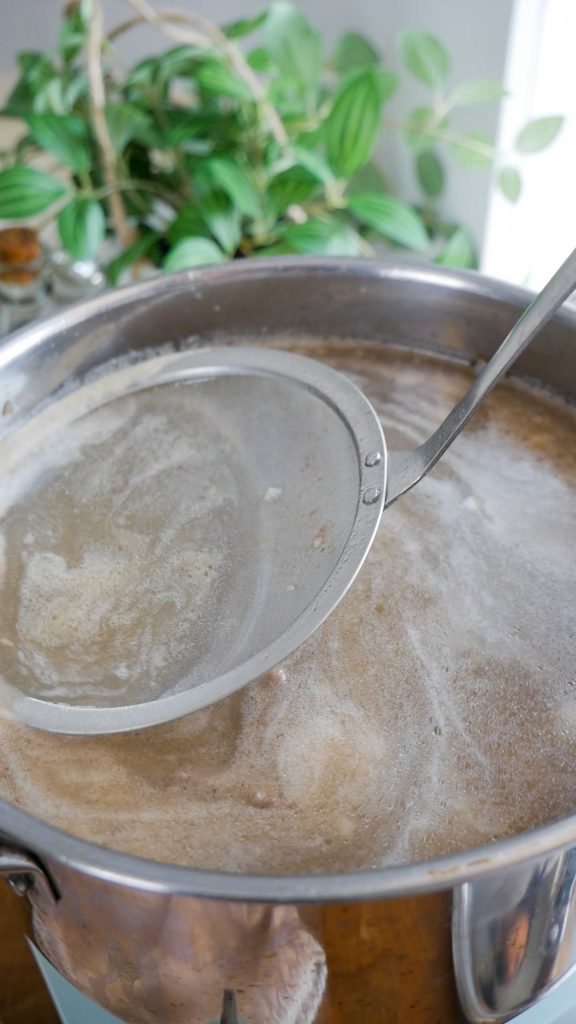

Step 7: Add other seasoning ingredients
Add the remaining minced garlic then season with fish sauce, salt, and dashida. Allow the soup to simmer for a few more minutes then garnish with chopped scallions.
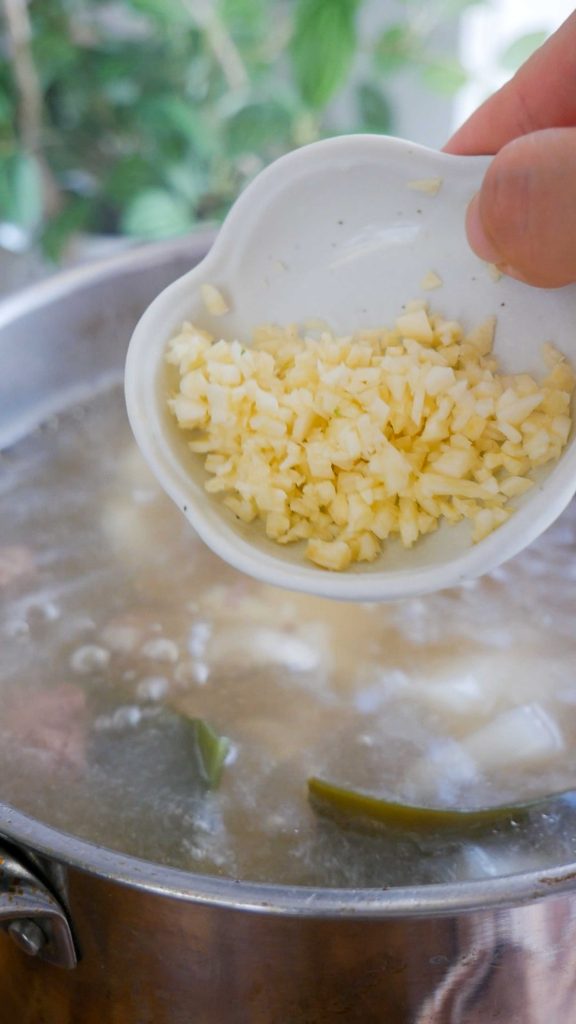
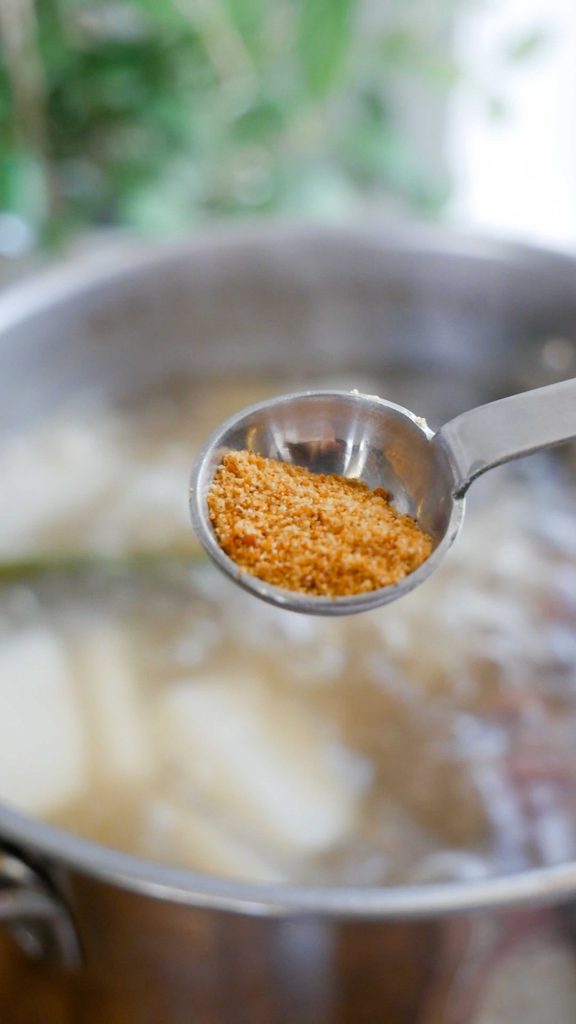

Step 8: Serve and enjoy
To serve, I like to add freshly cracked black pepper on top and enjoy with a bowl of rice.
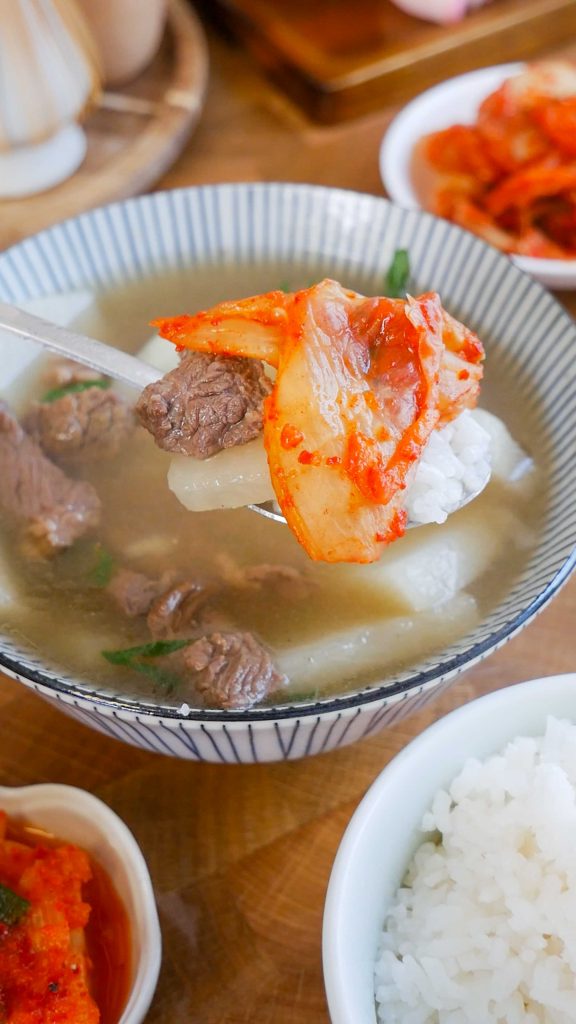
Preparation Tips for Korean Beef Radish Soup
Here are some helpful tips for making the most delicious Korean beef radish soup every time:
- When slicing the beef, you want to cut it across the grain. Doing so will make it easier to eat after cooking. If you don’t do this, you’ll end up having to eat strings of beef which is not necessarily bad and won’t affect the taste, but it’s just more pleasant to eat when sliced properly. Also, you want to slice the beef thinly to ensure that there is maximum surface area for the marinade to absorb into the beef.
- Slice the radish into uniform pieces to ensure that they all cook evenly at the same time. Ideally, you’d want them to be similar in size to the beef so it’s easier to eat.
- Some recipes do not saute the beef, however I think it deepens the flavor of the soup. Whenever you sear or brown meat, it intensifies the flavor, which is why I think it’s an important step.
- When searing the beef, start by heating up the pan really well. You want to hear a good sizzle once the beef hits the hot pan. Spread the beef out in one layer then leave it alone. This will ensure the beef browns and develops color, which as we discussed above is flavor. When you hear the sizzle slowly fading, they’re ready to be flipped.
- Take time to skim off the impurities that float to the top of the pot while simmering. This results in a clearer and cleaner soup.
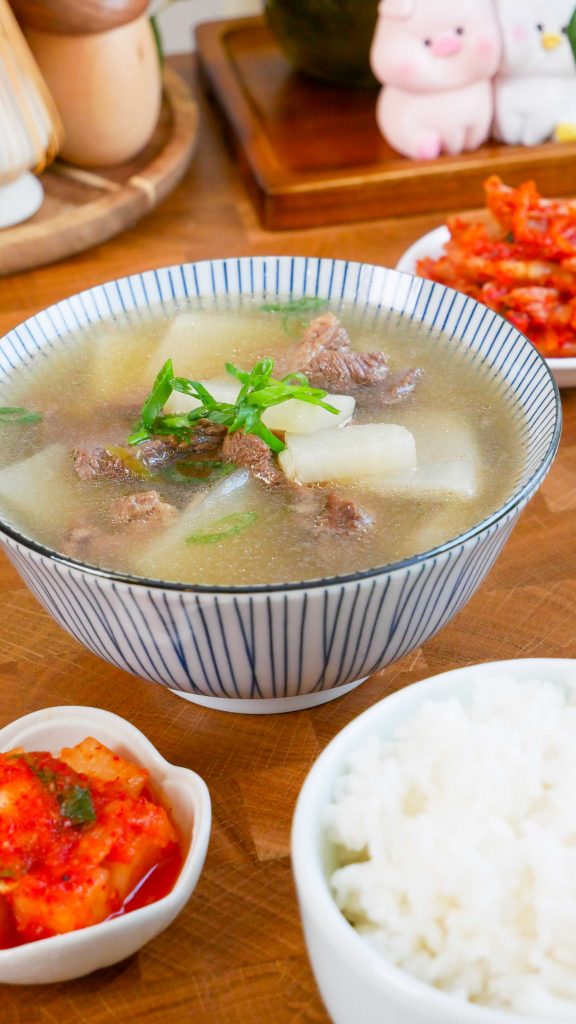
Frequently Asked Questions
What cut of beef is best for beef radish soup?
I recommend using beef brisket or chuck. Aside from being budget-friendly, these two cuts are the best for this soup because they have a rich beefy flavor and a lower fat-to-meat ratio. You can also use short ribs but they are usually pricey.
Can I substitute daikon radish for Korean radish?
Yes. Daikon radish and Korean radish are interchangeable for most recipes. They have a similar crisp texture that turns soft when cooked, and both are rich in nutrients and vitamin C. The slight difference lies in the flavor profile and shape. Daikon radish is on the sweeter side, while Korean radish also called mu radish is more peppery. Daikon is elongated with white skin, while Korean radish is short and rounded with the skin green from the top turning white towards the bottom. Both have bright white flesh.
Korean radish is often used for kimchi and other cooked dishes, such as this soup, as it holds its shape quite better than daikon. Daikon, on the other hand, goes great for salads, pickles, and condiments.
How long does it take to cook the beef radish soup?
This Korean beef radish soup is ready in under an hour, just about 45 minutes! That makes it a great menu option when you need to whip up something quick and hearty on a cold rainy night. Once everything is in the pot, you just need to let it simmer away.
What is the difference between soegogi-muguk and muguk?
Muguk is a general term used for radish soup. It comes from the Korean words “mu” meaning radish and “guk” meaning soup. Soegogi is a Korean word that translates to beef in English, which makes soegogi-muguk Korean beef radish soup.
What can I add to beef radish soup for more flavor?
Make your own version of Korean beef radish soup more flavorful making a 3 ingredient chili paste. To do this, combine equal parts gochugaru (Korean red chili flakes), fish sauce, and soup. I usually do 1 tablespoon each and it’s perfect for two people. After mixing the chili paste, add a dollop of it to the soup in the serving bowl. It adds a nice kick of spice from the gochugaru and an extra layer of umami from the fish sauce.
Looking for more easy and delicious soup recipes?
Korean Fish Cake Soup — Korean fish cake soup, also known as ‘odeng guk’ or ‘eomuk guk is a classic Korean street food made of fish cakes that are served skewered with broth and dip. It has a very flavorful and umami-rich broth, thanks to the anchovies, kelp, and chicken bouillon! The dipping sauce it’s served with is sweet and spicy, made with soy sauce, gochugaru, sugar, sesame oil, and aromatics.
Spicy Seafood Noodle Soup — If you’re looking for something spicy and refreshing, this seafood noodle soup is the recipe for you! It has a thicker broth compared to most noodle soups which makes the broth adhere to the noodles more, which makes each bite more flavorful!
Cabbage Soybean Paste Soup — This cabbage soybean paste soup feels like a warm hug in a bowl. It’s made with napa cabbage, doenjang, gochujang, soup soy sauce, aromatics, and my homemade anchovy powder, which really amps up the flavor! Best of all, it’s ready in just 25 minutes. You get a deep, complex flavor for just a little bit of time and effort.
Braised Pork Kimchi Jjim — This pork kimchi soup is loaded with umami flavors from pork neck bones, kimchi, and aromatics. I loaded it up with tofu for extra protein. Perfect with a bowl of rice!
Korean Rice Cake Soup — My mother often made this every New Year’s Day to welcome the good luck and prosperity in the New Year but you can have it any time of the year! I love its umami broth made with fish sauce, soup soy sauce, dashida, and garlic cloves served with chewy rice cakes.
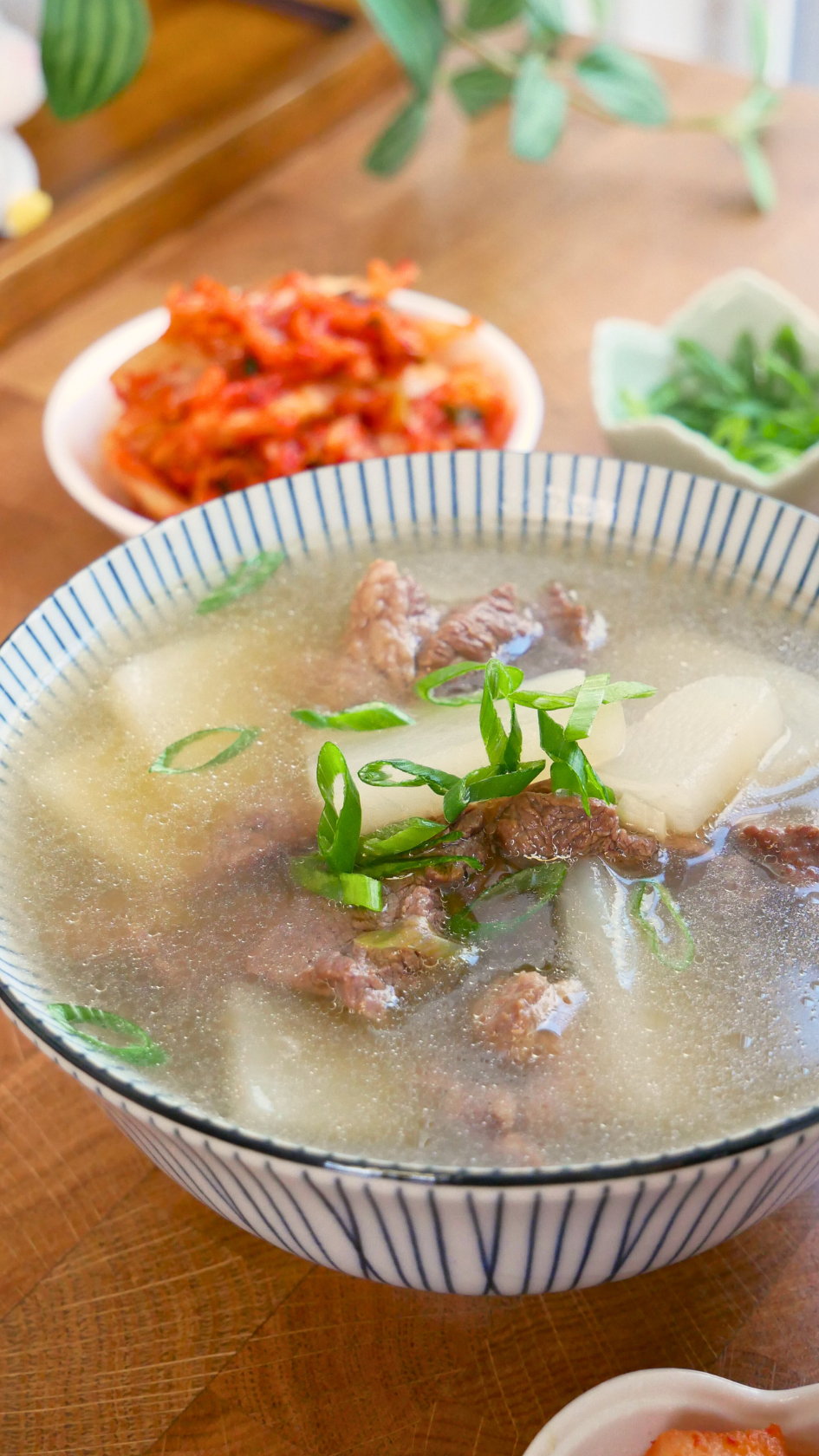
Korean Beef Radish Soup Recipe – 소고기 무국 (Soegogi Muguk)
Ingredients
- 12 oz beef brisket or chuck
- 1 tsp soy sauce
- 1 tsp sesame oil
- 4 minced garlic cloves divided
- 12 oz Korean radish washed and peeled, substitute with daikon radish
- 3 pieces dried kelp about 2×2 inches each
- 2 chopped scallions
- 1 1/2 tbsp fish sauce adjust to taste, substitute with soup soy sauce
- 1/2 tsp salt adjust to taste
- 1/2 tsp dashida (Korean beef bouillon) optional, adjust to taste
- 8 cups water
- 2 tbsp neutral oil
Instructions
- Start by slicing the beef thinly, about 1/4 inch pieces.
- Transfer the sliced beef into a small mixing bowl. Add soy sauce, sesame oil, and 2 minced garlic cloves. Mix well then set aside to marinate at room temperature for 15 minutes.
- While the beef is marinating, slice the radish 1/4 inch thick slices.
- Heat a pot over medium heat, then add neutral oil. Once the oil is hot, add the marinated beef and saute for 1 to 2 minutes until no longer pink.
- Add the radish to the pot then cook for 1 to 2 minutes.
- Pour in the water, then add the dried kelp. Cover and simmer for 25 minutes. After 25 minutes, check the radish to see if it's cooked through – the radish should be soft and tender. If it's not, simmer for another 15 minutes.
- Add the remaining minced garlic then season with fish sauce, salt, and dashida. Allow the soup to simmer for a few more minutes then garnish with chopped scallions.
- To serve, I like to add freshly cracked black pepper on top and enjoy with a bowl of rice.